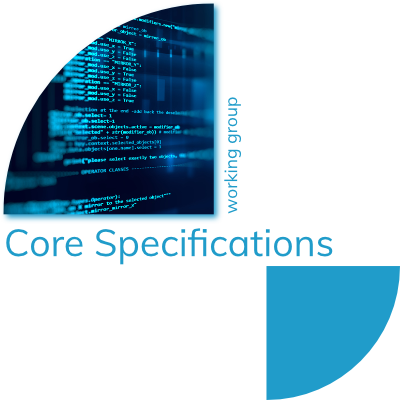Core Specifications
DLMS
Is short for Device Language Message Specification, and is the international standard for data exchange in energy and water smart management, advanced sensing and monitoring and innovative smart metering.
It aims to establish a standardized data exchange protocol for transmitting data between smart devices and head-end systems or amongst smart devices, in the energy or water sector.
It is internationally adopted under IEC 62056, ANSI C12, and EN13757-1 suites of standards.
The DLMS UA specifications include an object-oriented data model, an application layer protocol and media-specific communication profiles, that standardize message types for various operations, such as reading and writing data. Additionally, it also includes rules for formatting and transmitting these messages.
It can be applied over multiple types of communication technology. The development and maintenance of specifications adopted by IEC and ANSI is guaranteed by liaison agreements signed between DLMS UA and these respective organizations.
Blue Book
COSEM and OBIS application models are specified in the Blue Book.
Green Book
DLMS application layer, lower layers and communication profiles are specified in the Green Book.
Application Model
COSEM
Companion Object Specification Model is the object model capable of describing virtually any application.
Application Layer
DLMS
Device Language Message Specification is the application layer that turns the information held by the objects into messages.
Communication Profiles
Communication profiles specify how the COSEM data and the DLMS application layer can be used over lower layer communication protocols.
COSEM Companion Specification Model

The COSEM object model describes the semantics of the data exchange language. COSEM interface classes and their instantiations (objects) are flexible enough to model various energy and water management use cases and are general enough to model any application.
Object modeling is a powerful tool to formally represent simple or complex data, where each aspect of the data is modeled by an attribute. The objects can have multiple attributes and also methods to perform operations on the attributes.
The objects can be combined to model simple use cases such as register reading or more complex ones such as tariff and billing schemes or load management.
Currently, the specifications are capable of handling up to 65 535 interface classes.
OBIS codes are used to identify the type of energy or resource being measured, such as electricity, gas, water, or thermal energy. They are also used for abstract data that are not related to a specific type of energy or resource.
The hierarchical structure of OBIS codes allows for the classification of data characteristics e.g. electrical energy – active power – integration – tariff – billing period.
There are a total of 281 474 billion OBIS codes available, with 4 398 billion reserved for standardization purposes, while the remaining can be used for specific purposes such as manufacturer, country and consortia. The OBIS codes are strictly controlled by DLMS UA.
OBIS Naming system of COSEM objects

DLMS Application Layer Services Device Language Message Specification

The syntax of the language is specified by the DLMS services. DLMS/COSEM uses a client-server paradigm where the end devices, typically smart meters, act as servers and the head-end systems or concentrators are the clients.
The DLMS application layer provides:
– ACSE services to connect the clients and the servers;
– xDLMS services for accessing the data stored by the COSEM objects. The xDLMS services are the same for each object, enabling new objects to be added to the model without affecting the application layer.
The application layer also builds the messages (Application Protocol Data Units (APDU) applies, checks and removes cryptographic protection as needed and manages transferring long messages in blocks.
The messages can be transported over virtually any communication media and there are various built-in mechanisms to optimize the traffic to the media’s characteristics.
DLMS is communication technology agnostic, meaning that the application messages can be carried end-to-end, application-to-application between the entities hosting those applications, over virtually any communication technology.
For each communication technology, a communication companion stack is specified and defined by combining the flexibility and adaptability of the COSEM data and the DLMS application layer to the specificity of the lower layer communication protocol.
These specifications are published by IEC with a corresponding IEC62056-x-y reference.
Communication Profiles Stack Specifications

COSEM Companion Specification Model

The COSEM object model describes the semantics of the data exchange language. COSEM interface classes and their instantiations (objects) are flexible enough to model various energy and water management use cases and are general enough to model any application.
Object modeling is a powerful tool to formally represent simple or complex data, where each aspect of the data is modeled by an attribute. The objects can have multiple attributes and also methods to perform operations on the attributes.
The objects can be combined to model simple use cases such as register reading or more complex ones such as tariff and billing schemes or load management.
Currently, the specifications are capable of handling up to 65 535 interface classes.
OBIS codes are used to identify the type of energy or resource being measured, such as electricity, gas, water, or thermal energy. They are also used for abstract data that are not related to a specific type of energy or resource.
The hierarchical structure of OBIS codes allows for the classification of data characteristics e.g. electrical energy – active power – integration – tariff – billing period.
There are a total of 281 474 billion OBIS codes available, with 4 398 billion reserved for standardization purposes, while the remaining can be used for specific purposes such as manufacturer, country and consortia. The OBIS codes are strictly controlled by DLMS UA.
OBIS Naming system of COSEM objects

DLMS Application Layer Services Device Language Message Specification

The syntax of the language is specified by the DLMS services. DLMS/COSEM uses a client-server paradigm where the end devices, typically smart meters, act as servers and the head-end systems or concentrators are the clients.
The DLMS application layer provides:
– ACSE services to connect the clients and the servers;
– xDLMS services for accessing the data stored by the COSEM objects. The xDLMS services are the same for each object, enabling new objects to be added to the model without affecting the application layer.
The application layer also builds the messages (Application Protocol Data Units (APDU) applies, checks and removes cryptographic protection as needed and manages transferring long messages in blocks.
The messages can be transported over virtually any communication media and there are various built-in mechanisms to optimize the traffic to the media’s characteristics.
DLMS is communication technology agnostic, meaning that the application messages can be carried end-to-end, application-to-application between the entities hosting those applications, over virtually any communication technology.
For each communication technology, a communication companion stack is specified and defined by combining the flexibility and adaptability of the COSEM data and the DLMS application layer to the specificity of the lower layer communication protocol.
These specifications are published by IEC with a corresponding IEC62056-x-y reference.
Communication Profiles Stack Specifications


